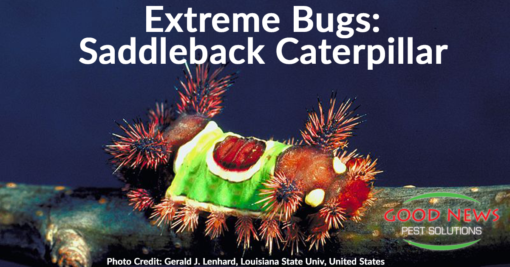
Extreme Bugs: The Saddleback Caterpillar
Any school-age child can tell you that a creepy crawly caterpillar folds itself into a cocoon and dies, only to emerge as a beautiful butterfly. It’s a story of transformation, resurrection, and beauty. Except it doesn’t always work that way. Our latest Extreme Bug is an example of how the process can work in reverse, how beauty isn’t always good and how interesting God’s creation is.
Sounds interesting...
The Acharia stimulea is a slug moth that can be found all across the Eastern side of the United States, including Florida. Once it emerges from its cocoon, it’s a rather glossy chocolate brown and black moth with just a few white specks to distinguish it from others in the Lepidoptera family. However, before it enters its silk-encased seasonal nap, it is far more beautiful and deadly, and known colloquially as the Saddleback Caterpillar (pictured above). Almost an inch in length, while it looks a whole lot prettier than most caterpillars and can be spotted in apple, oak, aster, dogwood, elm, maple, linden and citrus trees, touching it is a definite no-no. The sharp bristles on its body that flow out under the colorful coloring of the ‘saddle’ portion contain a venom so powerful that the barest touch can cause a sting as painful – and often more so – than a bee sting. And it lasts a bit longer.
So how do I identify it?
Examined from a safe distance, you can see that the caterpillar almost appears to have two horned heads, like the push-me pull-me from Doctor Dolittle. In between the double-pronged ends sits the colorful green and red carpet-like backing, framed in white, that gives the Saddleback Caterpillar its name. When born, the Acharia stimulea larvae are almost glowingly translucent. Within a month or so they develop their characteristic coloring and live for another 3-4 months, engorging themselves on leaves before wrapping themselves in an extremely tight cocoon for their metamorphosis.
Tell me more!
Another difference between normal caterpillars and Saddleback Caterpillars is that instead of the tiny clutching feet borne by most of their species, they could be likened more to a spider – little suckered feet that ooze bits of high-tensile silk. The moths’ mating flight period is June to July for up to 24-hours per coupling, and in Florida, the caterpillars emerge and are most active in February and March.
But it's dangerous, right?
Again, if you see this colorful insect, DO NOT TOUCH it. Just leave them alone. Okay, maybe snap a photo. But be careful. If you do get poked, get the tiny spiky hairs out immediately, then head to the hospital for treatment. If you have any other insects invading your home or yard, give us a call here at Good News Pest Solutions and we’ll be happy to send out one of our highly trained technicians to take care of the problem with our 100% natural, organic pest control solutions that are safe for the whole family. From Bradenton to North Port, you can count on Good News Pest Solutions!
« Back to BlogProudly Serving
Sun City Center, Ruskin, Palmetto, Parrish, Ellenton, Bradenton, Anna Maria, Holmes Beach, Bradenton Beach, Longboat Key, Lakewood Ranch, University Park, Myakka City, Sarasota, Siesta Key, Osprey, Nokomis, Casey Key, Venice, Englewood, North Port, Port Charlotte, Punta Gorda, Arcadia
Things You Can Do
Pay Your Bill Online
Leave Us a Review
Request a Free* Termite Inspection
Stop Mosquito Bites
Get Rid of Rodents
Get a Termite Damage Warranty
Get Pest Control for Your Attic
Get Pest Control for Your Business Request Prayer
Corporate Address
1080 Enterprise Court, Ste A
North Venice, FL 34275
Call Now: (941) 412-9610
Text: (941) 412-9610
Fax: (941) 412-0080
